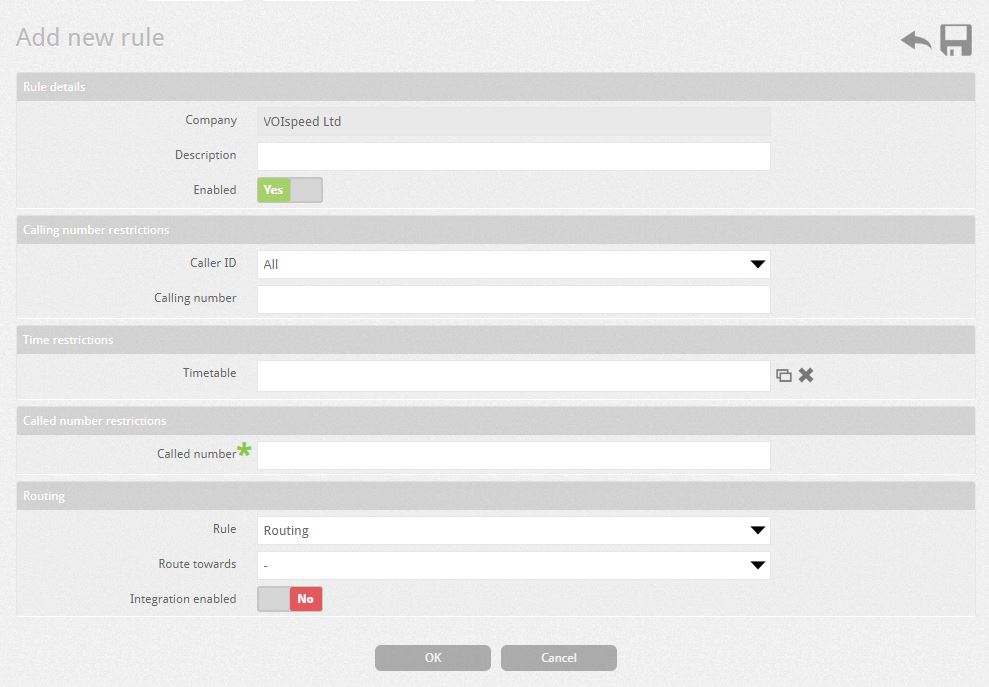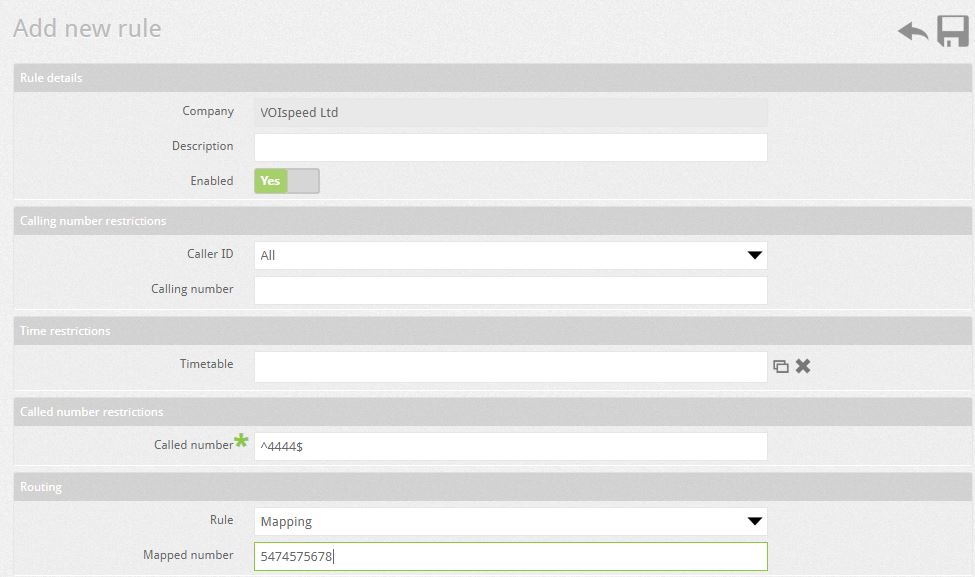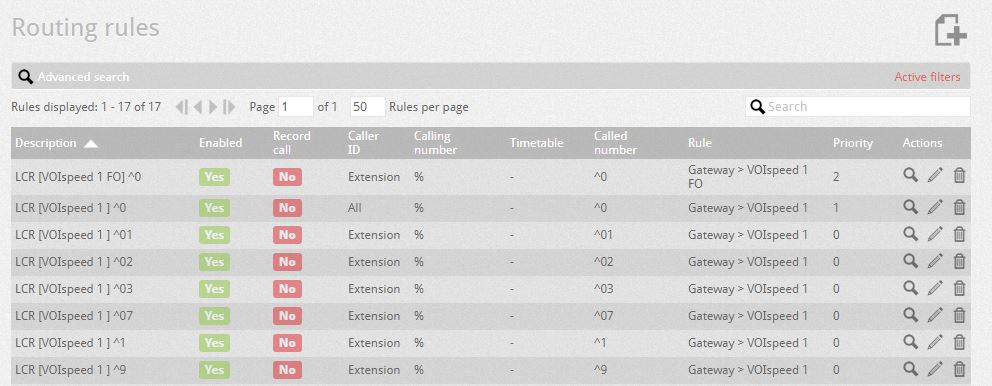Routing rules are used to tell the PBX how to handle calls (incoming and outgoing) based on different selection criteria. The routing takes care of selecting the gateway on which to forward outgoing calls, sorting incoming calls to the said switchboard entities. A routing rule is essentially composed of a criterion that allows to associate numbers to one and only one entity and then decide the route for the destination of a call.
NOTE : this section of the PBX should normally only be used for special advanced settings (see below), since the main routes for outgoing and incoming calls are made through the LCR module and the Wizard of business numbers .
From the Toolbox -> Routing menu you access the list of existing routing rules. The buttons  ,
,  ,
,  serve respectively to eliminate, consult and modify the configurations.
serve respectively to eliminate, consult and modify the configurations.
To create a new routing rule click on the icon  . The parameters available are the following:
. The parameters available are the following:
| Parameter | Description |  |
| Company | Company for which the rule is applied | |
| Description | Description of convenience for the rule | |
| Enable | Activate / deactivate the rule | |
| Register Call | Activate the automatic registration of calls that pass through this rule. At the same time the user can also record the call via his GUI.
NOTE: the recording takes place using the G.711 codec (uncompressed, from about 80 kbps per conversation): therefore if the call is made through a VoIP operator it could be disturbed due to the quality of the ADSL connection or in conjunction with a large number of calls |
|
| Caller Type | Type of caller on which the rule is activated. There are 2 types: External: all calls from Internal Gateway: calls from PBX entities (users, IVRs, etc.) |
|
| Calling Number | It is the caller number or prefix. For entry rules v. REGULAR EXPRESSIONS lower down. The wildcard ‘%’ generalizes the rule for any calling number | |
| Hourly table | Indicates when the rule should be applied, by choosing a time table | |
| Called Number | It is the called number or prefix. The wildcard ‘%’ generalizes the rule for any number called. | |
| Rule | Allows you to select the type of rule, choosing between “Routing” and “Mapping” | |
| Route to |
If on the previous item “Routing” was chosen, it indicates the entity on which the call managed by the rule will be routed (User, Group, Gateway, IVR); in particular, selecting the Gateway item, it will be possible to access two other entries:
|
|
Mapped Number |
If in the previous item “Mapping” was chosen, this field allows you to enter the number on which the call is mapped; the rule is useful for the creation of short numbers (eg. Enter a code to call business phones) or to manage the pass-through selection. | |
| Integration enabled | Enable SSN integration for the current routing rule: when the call “transits” for this rule, the PBX will execute the script indicated based on the selected event (for more information see the section Settings in the chapter configure the company ). | |
SELECTION CRITERIA OF THE RULES
The call routing rules for a particular number (N) are chosen by the system based on comparison criteria: each comparison provides a score . The scores obtained by the different comparisons are added together and the results obtained are used as priority values: the rule that obtains the highest score will be chosen. Within a company the criteria used for choosing a rule are the following:
- Called Number : the N number is compared with the called number. The highest score is assigned to the rule that provides the greatest number of matches, or the longest match (eg: a rule for the entire prefix “347” wins on the rules for the prefix “3”, when calling the number 347 / 1234567);
- Time band : if there are two or more matches of the same score in point 1, the time band is compared: the highest score is assigned to the rule in which the time band (if set) includes the current time of the current call;
- Calling Number : if there are two or more matches of the same score in point 2 or no time slot is set, the number of the set caller is compared. Here too, as point 1, the greater the correspondence, the higher the priority.
REGULAR EXPRESSIONS (REGULAR EXPRESSIONS)
In order for checks to be carried out on entire categories of numbers (eg national, district, international, mobile, etc.) it is possible to define ranges of numbers and strings in a powerful and flexible way thanks to the introduction of regular expressions . A regular expression is a sequence of symbols (hence a string) which in turn identifies a set of strings. Thanks to a particular symbology and a simple syntax it will be possible to build rules to identify sets of numbers.
VOIspeed 6 uses a subset of the regular expressions commonly known in computer science: to be precise, 2 symbols are used to identify the beginning and end of the strings and a Jolly symbol to identify any string.
| Symbol | Description | Examples |
| ^ xx | String start : indicates all the numbers that start with xx | ^ 0 : numbers starting with 0 (national fixed and international numbers) ^ 00 numbers starting with 00 (international) ^ 3 : numbers starting with 3 (mobile) ^ 347: numbers starting with 347 ^ + 39: numbers that begin with the Italian international prefix +39 |
| % | Wildcard character | special character indicating “all numbers”. If used in the “called number” field, it can then be used to indicate ALL outgoing prefixes to compact the routing rules. |
| $ | End of string : indicates the end of the string |
Note : the routing rules compare the criterion entered by the administrator with the numbers always starting from the first character , therefore you will notice how the system always automatically inserts the symbol of beginning string (^) even if omitted by the administrator. This also implies that when you insert the end-of-string symbol ($), in fact you are defining a complete number (which assumes an exact comparison 1: 1).
Here are some other examples:
| User rule | Description |
| ^ 0 | All numbers starting with 0 (national landlines) |
| ^ 06 | All numbers starting with 06 (Rome numbers) |
| ^ $ 187 | Same numbering at 187 (number of Telecom Italia customers) |
| ^ $ 123 | Equal numbering at 123 |
| ^ $ 0733811720 | Equal numbering at 0733811720 |
| ^ 073381188 | All the numbers starting with the numbers 073381188. This rule can be used, for example, to manage the pass-through selection with root 073381188 |
If more criteria are successful in comparison with a number, the criterion containing the greatest number of digits will be chosen (ie the one that offers the longest match). For example, with the number 02123 456789 , between the two criteria ^ 02123 and ^ 02, the first would “win”.
MAPS
Mapping rules apply a “transformation” from one number to another. The mapping is used for the management of the pass-through selection and the creation of short numbers to call real numbers (for example, the business phones of one’s colleagues).
In this last case, it is very simple to create a short number to call a real number: for example, if you wanted to use the code 4444 , to call the number 3471234567 , the rule will be made like this:
 Warning: do not use codes that coincide with the switchboard extensions or with emergency numbers (112, 113, 118, etc.)
Warning: do not use codes that coincide with the switchboard extensions or with emergency numbers (112, 113, 118, etc.)





